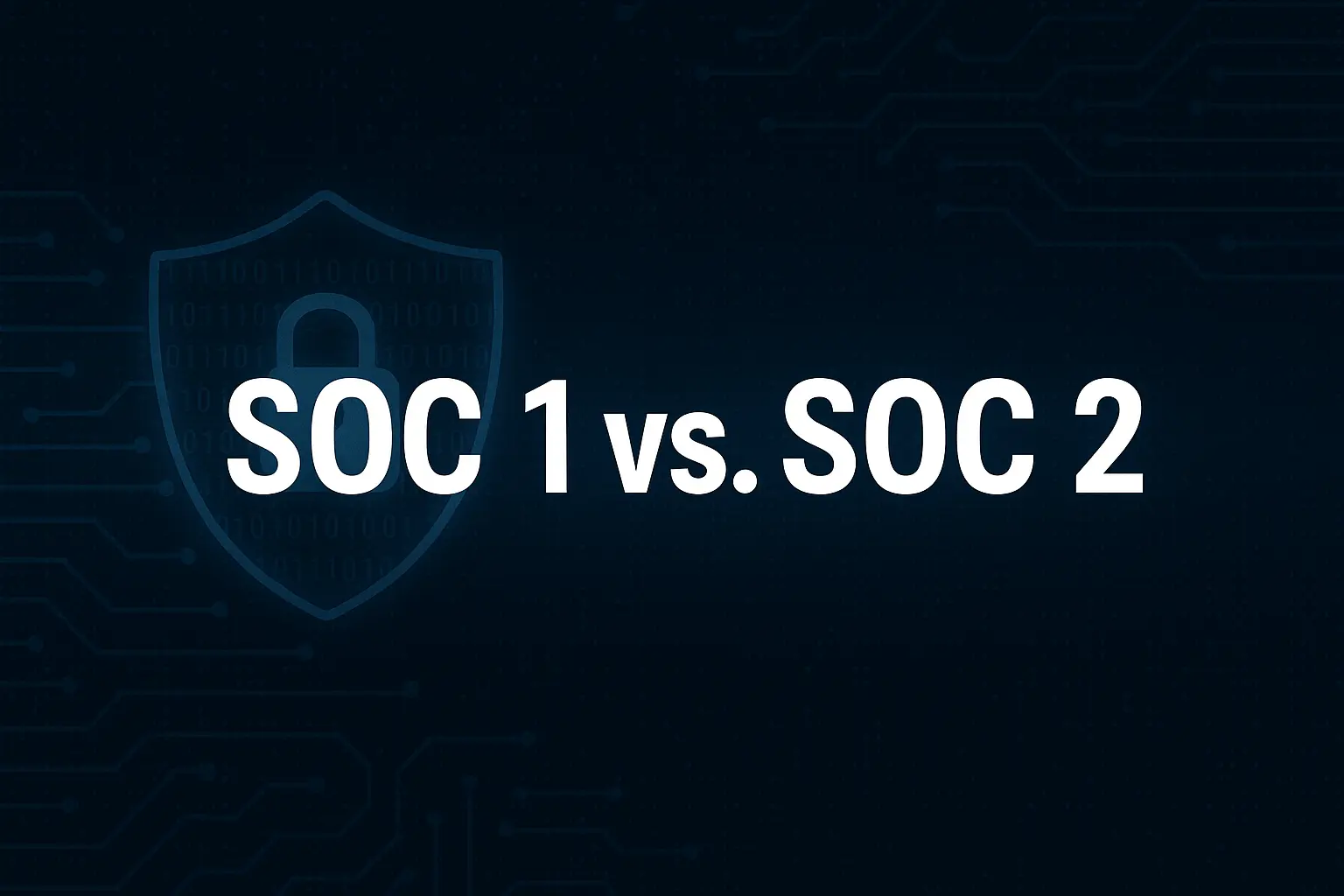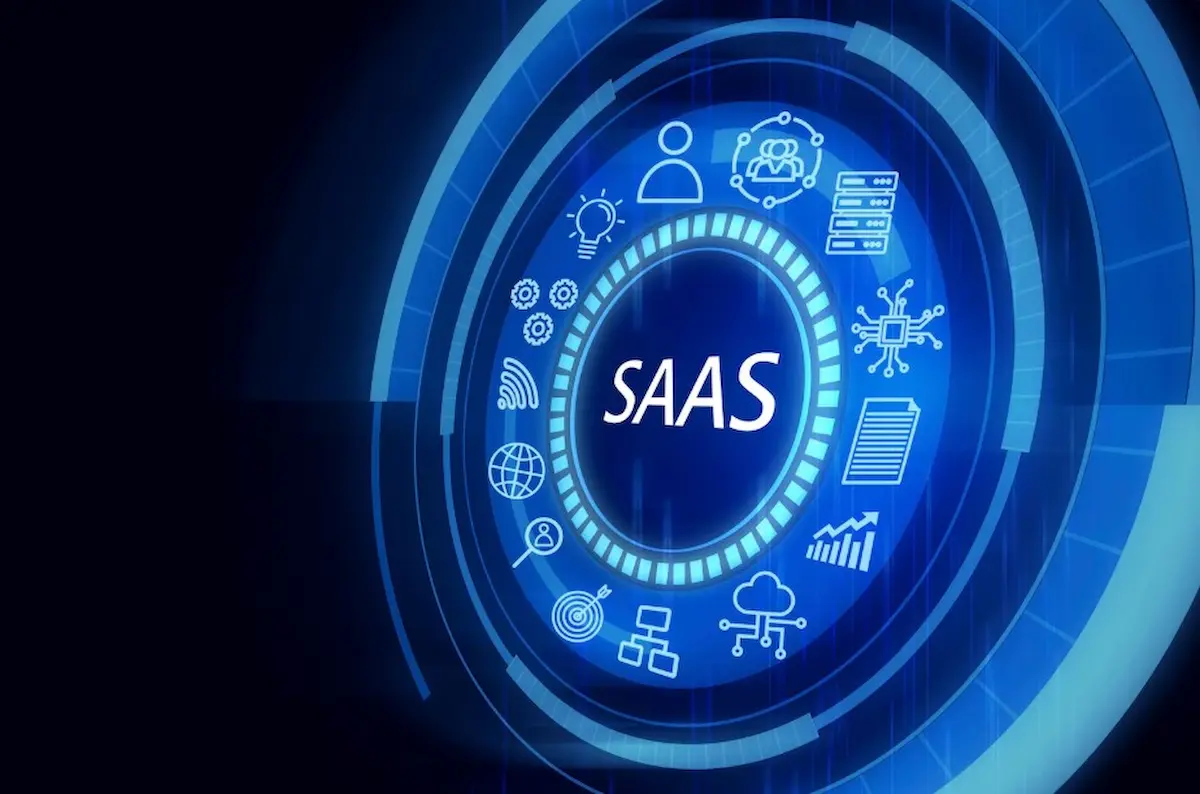SOC 1 vs. SOC 2: Understanding the Key Differences
CYBERSECURITY
/
October 30, 2025

Discover the key differences between SOC 1 and SOC 2 reports, their purposes, audiences, and audit criteria to choose the right compliance framework for your organization’s security and financial assurance.
For any service organization that handles customer data, providing assurance over its internal controls is no longer a luxury. It is a business necessity. In the world of third-party risk management, the most widely recognized and respected validation tools are the System and Organization Controls (SOC) reports (1; 2). However, a critical point of confusion often arises for leadership teams: should we pursue a SOC 1 or SOC 2 report? Understanding the SOC 1 vs SOC 2 comparison is a crucial strategic decision that impacts your sales process, customer trust, and compliance obligations.
This guide provides a clear, practical explanation of the difference between SOC 1 and SOC 2 reports. We will explore their distinct purposes, the different criteria they are audited against, their target audiences, and the specific business scenarios where each is appropriate. For any organization trying to answer the question, "What is the difference between SOC 1 and SOC 2?", this guide will provide the clarity needed to make an informed decision, plan your audit, and effectively communicate your security and compliance posture to your customers and their auditors.
Part 1: Defining the Reports: A Deep Dive into SOC 1 and SOC 2
Before making a direct comparison, it is essential to understand what each report is on its own. While both are attestation reports governed by the American Institute of Certified Public Accountants (3), they are designed to answer fundamentally different questions (1; 2). Answering "what are SOC 1 and SOC 2 reports?" starts with understanding their unique objectives.
What is a SOC 1 Report? Focusing on Financial Controls
A SOC 1 report is formally known as a "Report on Controls at a Service Organization Relevant to User Entities' Internal Control over Financial Reporting (ICFR)" (1).
Primary Purpose: The sole purpose of a SOC 1 report is to provide assurance to a service organization's clients that the services provided will not negatively impact their financial statements. It focuses exclusively on the controls at the service organization that are relevant to their clients' financial reporting.
Key Audience: The primary audience for a SOC 1 report is not the client's security or IT team but rather the client's financial auditors. The client's auditors will use your SOC 1 report to help them plan and execute their own financial statement audit of your client.
Audit Criteria: A SOC 1 is audited against the service organization's own control objectives, which are the specific goals the organization claims its controls are designed to achieve.
Use Cases: SOC 1 reports are necessary for service organizations whose services are an integral part of their clients' financial processes, such as payroll processors, medical billing companies, and loan servicing companies.
Type 1 vs. Type 2: A Type 1 report is a "point-in-time" review of control design. A Type 2 report is more comprehensive, testing the operating effectiveness of controls over a period of 6 to 12 months (Wipfli).
What is a SOC 2 Report? Focusing on Security, Availability, and More
A SOC 2 report is formally known as a "Report on Controls at a Service Organization Relevant to Security, Availability, Processing Integrity, Confidentiality, or Privacy" (2). It has a much broader applicability and has become the de facto standard for demonstrating security assurance (2).
Primary Purpose: The purpose of a SOC 2 report is to provide assurance to a broad range of stakeholders that a service organization has effective controls in place to protect the data it is entrusted with.
Key Audience: The primary audience is the service organization's current and prospective customers, business partners, and their management teams.
Audit Criteria (The Trust Services Criteria): A SOC 2 is audited against the AICPA's predefined Trust Services Criteria (TSCs). These are organized into five categories:
- Security (Common Criteria): Always required.
- Availability
- Processing Integrity
- Confidentiality
- Privacy.
Use Cases: SOC 2 reports are relevant for nearly any organization that provides a service where they store, process, or transmit customer data, such as SaaS providers, cloud hosting providers, and managed IT services.
Type 1 vs. Type 2: The distinction between SOC 1 and SOC 2 (Type 1 and Type 2) is the same as for a SOC 1. A Type 2 report provides a much higher level of assurance and is what most customers will demand.
Read also: SOC 2 vs ISO 27001: What’s the Difference
Anatomy of the Report: What's Inside
Both SOC 1 and SOC 2 reports follow a standardized structure (4).
Section 1: The Independent Service Auditor's Report. This is the auditor's formal opinion letter. The best possible result is an "unqualified" opinion.
Section 2: Management's Assertion. This is a letter from the service organization's management, formally asserting that their system description is accurate and their controls are effective.
Section 3: Management's Description of the System. This is the detailed narrative where the company describes its services, processes, and the control environment.
Section 4: The Auditor's Tests of Controls and Results (Type 2 Only). This is the detailed matrix that lists each control, the auditor's test procedure, and the results of the test (4).
Part 2: A Head-to-Head Comparison: The SOC 1 and SOC 2 Difference
While the reports share a common heritage, the SOC 1 and SOC 2 difference is profound.
Purpose and Audience: Financial Audit Support vs. Security and Operational Assurance
A SOC 1 report has a very narrow purpose. It gives a client's financial auditors comfort that your services will not cause a material misstatement in their financial reports.
A SOC 2 report has a much broader purpose. It gives your clients and partners confidence in your overall security and operational posture.
Audit Criteria: ICFR Control Objectives vs. the Trust Services Criteria
A SOC 1 audit is performed against the service organization's own control objectives related to financial reporting.
A SOC 2 audit is performed against the AICPA's predefined Trust Services Criteria (2; 3).
Evidence Requirements: A Practical Comparison
The type of evidence you must collect differs significantly between the two reports, reflecting their different goals.
SOC 1 Evidence is narrowly focused on proving the control objectives related to financial processing. An auditor will ask for evidence like:
- Screenshots of system configurations that enforce segregation of duties in a financial application.
- Change management tickets for modifications to financial reporting algorithms or transaction processing logic.
- Logs demonstrating that access to financial databases is restricted to authorized finance personnel.
- Evidence of reconciliations and error handling procedures for financial transactions.
SOC 2 Evidence is much broader and is focused on the general security and operational health of the system. An auditor will ask for a wider range of evidence, such as:
- Results of quarterly vulnerability scans and reports on the timeliness of patching.
- Records from quarterly user access reviews for all production systems, not just financial ones.
- The after-action report from your most recent annual incident response and disaster recovery tests.
- Signed security awareness training acknowledgments from new hires and annual refreshers for all staff.
- Evidence of security risk assessments performed on your key third-party vendors.
Use Cases: When to Choose SOC 1 or SOC 2
The decision of SOC 1 or SOC 2 is driven entirely by the nature of your service and the needs of your customers.
Choose a SOC 1 if: Your service has a direct, material impact on your clients' financial reporting.
Choose a SOC 2 if: Your customers are entrusting you with their sensitive operational data and need assurance that you have a strong security program.
It is a common misconception that a SOC 2 is "better" than a SOC 1. This is incorrect. They have different purposes, and one cannot replace the other.
Part 3: Synergy and Strategy: Navigating a SOC 1 and SOC 2 Audit
For some organizations, the choice is not SOC 1 versus SOC 2. Instead, they have a need for both (1; 2).
Can an Organization Need Both a SOC 1 and a SOC 2 Report?
Yes, this is a common scenario. Consider a FinTech SaaS company that provides a platform for managing corporate expenses.
Their service processes financial transactions, so their clients' financial auditors will demand a SOC 1 report.
Their platform also stores sensitive employee and corporate data, so their clients' security teams will demand a SOC 2 report.
Streamlining Your Efforts: A Unified Approach to a SOC 1 and SOC 2 Audit
The good news is that much of the work to prepare for these audits overlaps. Many foundational controls, such as Change Management, Logical Access, and Incident Response, are common to both. An efficient approach to SOC 1 and SOC 2 compliance is to build a Unified Control Framework. This involves testing these common controls once and then using the results to satisfy the requirements of both the SOC 1 and SOC 2 audit.
Beyond the First Audit: Maintaining Your SOC Compliance
Achieving your first SOC 2 Type 2 report is a major milestone, but it marks the beginning of an ongoing annual compliance cycle.
The Continuous Cycle: Your SOC 2 Type 2 report covers a specific observation period (e.g., October 1, 2024, to September 30, 2025). As soon as that period ends, a new one begins. This means that evidence collection is a year-round activity (5).
Bridge Letters: To cover the "gap" between the end of one report's observation period and the issuance of the next report, organizations often provide a "bridge letter." This is a letter from management that attests that there have been no material changes to the control environment since the last audit (6).
Managing Exceptions: No control environment is perfect. During your observation period, a control may fail. It is critical to have a formal process for documenting these control failures or "exceptions." An auditor will review these. A few well-documented exceptions, along with evidence of your remediation efforts, are generally acceptable to customers. It shows that you have a mature and honest process for managing your controls.
A Practical Checklist for Your First SOC Audit
The overall journey to your first attestation follows a predictable path.
- Determine the Right Report and Scope: Choose between SOC 1 and SOC 2. For a SOC 2, select which of the five Trust Services Criteria will be in scope.
- Perform a Formal Readiness Assessment: Conduct a gap analysis to identify all your control deficiencies before the formal audit begins.
- Remediate the Gaps: Execute a project plan to fix the identified issues.
- Select an Audit Firm (CPA Firm): Choose a qualified CPA firm with deep experience in your industry.
- Define the Observation Period (for a Type 2): Formally define the start and end dates for your audit period (5).
- Collect Evidence: Gather evidence throughout the observation period to prove that your controls are operating consistently.
- Write the System Description: Draft the detailed narrative for Section 3 of the report. This is a management responsibility and is a significant writing effort that should be started early (4).
Conclusion
The SOC 1 and SOC 2 report differences are clear and significant. The difference between SOC 1 and SOC 2 reports is fundamentally one of purpose. SOC 1 is for financial audit support, while SOC 2 is for security and operational assurance. One is not better than the other; they are different tools for different jobs. The right choice depends entirely on the service you provide and, most importantly, the assurance needs of your customers (1; 2). By understanding this distinction, you can select the right report, scope your audit correctly, and provide your customers with the specific and relevant trust they require.
Sources
- AICPA — SOC 1®: SOC for Service Organizations – ICFR — https://us.aicpa.org/resources/article/soc-1
- AICPA — SOC 2®: SOC for Service Organizations – Trust Services Criteria — https://us.aicpa.org/resources/article/soc-2
- AICPA — Trust Services Criteria (2017, updated 2022) — https://us.aicpa.org/resources/article/trust-services-criteria
- AICPA — Illustrative SOC 2 Report and Description Criteria — https://www.aicpa.org/resources/article/soc-illustrative-report
- Wipfli LLP — SOC 2 Type 1 vs. Type 2: Choosing What’s Best for Your Organization — https://www.wipfli.com/insights/articles/advisory-soc-2-type-1-vs-type-2
- K Financial — CSOCs and CUECs in a SOC Report — https://kfinancial.com/csocs-and-cuecs-in-a-soc-report/


FAQ
What is the main difference between SOC 1 and SOC 2?
The main difference between SOC 1 and SOC 2 is their purpose. A SOC 1 report focuses on controls relevant to a client's financial reporting (ICFR). A SOC 2 report focuses on controls relevant to security, availability, processing integrity, confidentiality, and/or privacy.
Can a SOC 2 report replace a SOC 1 report?
No. They serve different audiences and purposes. If your client's financial auditors require a report to support their audit, they will need a SOC 1. A SOC 2 will not meet their needs.
Which report is more difficult to get?
Neither is inherently "more difficult"; they are just different. The difficulty depends on the maturity of your existing control environment.
What is the difference between a Type 1 and a Type 2 report?
A Type 1 report (sometimes written as SOC I) assesses the design of your controls at a single point in time. A Type 2 report (sometimes written as SOC II) tests the operating effectiveness of your controls over a period of time. A Type 2 report provides a much higher level of assurance (5).





















